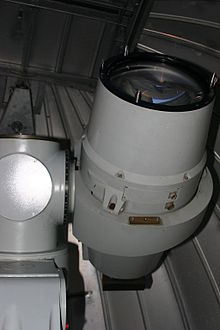Satellite station Graz-Lustbühel

The Graz-Lustbühel satellite station , which is part of the Lustbühel observatory, is Austria's fundamental station for cosmic and satellite geodesy .
Location and purpose
It is located near the outskirts of the Styrian capital Graz in the ninth district of Waltendorf on a Riedel , which at this point bears the name Lustbühel . The observatory also serves the purposes of astronomy and communications engineering and thus houses facilities of the University of Graz , the Technical University of Graz , and the Austrian Academy of Sciences .
Measurement equipment
The satellite station has a large satellite camera by building type Zeiss DT 75 , which a few years ago in cooperation with the Vienna University of photographic plates on CCD was rebuilt technique. Since then it has also been used to observe asteroids and to detect space debris.
Additional features include:
- The measuring unit for Satellite Laser Ranging (SLR). It is already the third measuring unit developed in Graz since the 1970s and was the first in the world to fall below the 1 cm accuracy limit. With some laser satellites , the team achieved the first measurements after the launch (see also GFZ-1 );
- a range of GPS and GLONASS receivers for precise distance measurements ( pseudoranging and dGPS ) to the 20,000 km high orbiting satellites of the NAVSAT system and the future Galileo satellite navigation ;
- Both measurement methods (LASER and GPS) contribute significantly to the worldwide monitoring of the earth's rotation and the polar movement - see IGS and IERS .
- Additional receivers and antennas for special purposes ( microwaves , Doppler , etc.)
History and form of organization
In 1943, at the suggestion of Karl Stumpff, the municipality leased a plot of land near Lustbühel Palace in the east of Graz in order to build a small observatory on it. The reason for this was the fact that the observation conditions at the University of Graz were getting worse and worse. In 1957 Oskar Mathias achieved that this property was purchased by the federal government and that in 1969 a total area of 18,455 m² was achieved through further acquisitions. Since all applications for the construction of a small observatory were initially negative, Prof. Mathias decided to help himself: The telescopes he made were installed in small wooden huts. The foundations of this building can still be seen in the southern area of the property.
At the end of the sixties , a new path opened up: Due to the direct interest of the Institute for Meteorology and Geophysics at the University ( Otto Burkard ) and the then Institute for Geodesy II at the Graz University of Technology ( Karl Rinner ), both of which were an undisturbed location for satellite observations outside the city was able to motivate the authorities to take up new activities. In 1971 the spatial and functional program of an observatory was drawn up, and corresponding plans were drawn up by the state building office, which could then be submitted to the ministry. In the meantime, the Institute for Telecommunications and Wave Propagation of the Graz University of Technology ( Willibald Riedler ) was added as a fourth partner.
In June 1972 the authorities gave their approval, and in August 1974 construction began, which was also to serve the newly founded Space Institute (IMF) of the Austrian Academy of Sciences. The entire project was supported by the City of Graz and the Science Promotion Fund (FWF). The grand opening took place in December 1976. After more than thirty years of operation, the observatory was renovated inside and outside between August and December 2007.
The satellite station, founded around 1970, should originally have been built in the area of the TU Vienna , but was relocated to the climatically more favorable southern Styria on the recommendation of Karl Ledersteger , where a research group for satellite geodesy led by Karl Rinner and Günter Chesi at the TH Graz as early as the 1960s had formed. A cooperation with researchers in electrical engineering (Prof. Willibald Riedler) already existed.
As already mentioned, the Austrian activities in the field of space research were brought together in Graz in 1974 and the Institute for Space Research was founded. The institute, which is currently headed by Wolfgang Baumjohann , is divided into the following four research areas:
- (Exo-) planetary physics
- Space plasma physics
- Satellite laser ranging
- Flight instruments.
In the meantime, this institute with more than 80 employees from fourteen different nations has become one of the largest institutes of the Academy of Sciences . Since the employees of this facility were spread over six locations in Graz, the OeAW established the Victor Franz Hess Research Center Graz (OeAW-FZG) in Graz-Messendorf between 1998 and 2000 in order to concentrate all activities at one location as far as possible. Only the research area Satellite Laser Ranging remained at the Lustbühel Observatory.
See also
literature
- Maria G. Firneis, Hermann Haupt, Peter Holl: Observatories in Austria , ( online )
Web links
- Web presence of the Institute for Space Research
- Website of the Lustbühel Observatory, area of geophysics, astrophysics and meteorology of the Institute for Physics at the University of Graz
- SLR Global Performance Report Card (English)
Coordinates: 47 ° 4 ′ 1.6 ″ N , 15 ° 29 ′ 36.7 ″ E

